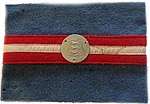5 Kolonne
| 5th Column 5. Kolonne | |
|---|---|
| Participant in Second World War | |
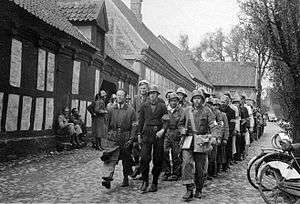 Resistance group 5. Kolonne in The Old Town museum | |
| Active | June 1943 - June 1944 |
| Leaders | Ernst Fisker |
| Headquarters | Aarhus, Denmark |
| Size | 130 |
| Part of | Danish resistance |
| Opponents |
|
5. Kolonne was an organization using violence and sabotage to oppose the occupation of Denmark by German forces during the Second World War.[1] The organization was formed and based in Aarhus and with some 100 members it was one of the larger resistance groups in that area in the later years of the war. The group was created in response to the destruction of the resistance groups in Jutland by the Gestapo between late 1943 and the summer of 1944. The group functioned from June 1944 to the end of the occupation in May 1945.
Background
The Danish resistance was in the early years of the occupation dominated by communists, forced underground when the Danish government signed the Communist Law on 22 August 1941. In Aarhus there were a number of such groups, focused on disrupting production, telecommunications and transport networks. Generally the resistance groups had become increasingly active over the years as their members grew in numbers, gained experience and developed networks. Supporting the sabotage groups were groups focused on receiving supplies through allied airdrops, so-called receiver-groups (Danish: Modtagergruppe), a network which had also taken time to develop. By 1943 weapons and supplies were arriving with regularity and communications had been established with the central resistance command and contacts in England.[2]
On 13 December 1943 the British paratrooper Jakob Jensen was caught by the Gestapo in Aarhus. During interrogation he supplied information about the networks of receiver groups in Jutland which resulted in many groups being destroyed, including the Hvidsten Group whose members were arrested on March 11, 1944. These events effectively crippled the resistance movement throughout the peninsula as supplies dried up. In Aarhus the resistance groups faced another problem as Grethe Bartram from the communist and resistance environment in Aarhus was hired as an informant by the Gestapo in March/April 1944. Bartram in total informed on some 50 resistance members leading to many groups in and around the city being dismantled by German authorities, including the Samsing Group in June 1944.
The events in the 6 months from December 1943 to June 1944 had effectively wiped out the leadership of the resistance in Jutland and stopped resistance operations in Aarhus.[3] The city was, however, an important seaport and rail hub for the German war effort with troops and supplies arriving frequently from Germany to be shipped out through the Port of Aarhus to Oslo and Riga. German authorities had until the Invasion of Normandy on June 6, 1944 also been concerned that an allied invasion might take place in Jutland and had extended the Atlantic Wall along its west coast while concentrating administrative institutions in the peninsula to prepare defenses. The German headquarters for Denmark was moved from Copenhagen to Silkeborg in November 1943,[4] the Gestapo headquarters for Jutland was moved to Aarhus in September 1943[5] and the supply headquarters for Denmark was moved to Aarhus in October 1943.[6] Combined these factors had made Aarhus an area of particular interest for the resistance movement and it was considered a priority to re-establish new groups that could disrupt German operations.[7]
In the spring of 1944 lieutenant commander Ernst Fisker from the 3rd Field Artillery Brigade, stationed in Aarhus' Langelandsgade Barracks prior to the war, came into contact with the resistance movement in Aarhus.[7] He was encouraged by the commander of the resistance in Jutland to take command of any units in Aarhus, build up a new command structure and develop sabotage groups that could interfere with German operations, especially the railway.[8]
Formation
The first groups in the new organization were formed over the early summer of 1944. Initially one group was to obtain supplies while two others were sabotage groups, primarily intended to target infrastructure; in particular the railway and port. The first shipment of weapons was collected in July and the first operation against the railway occurred later that month when the rail line to Randers was bombed as a means of testing equipment.[8] In August the Holger Danske resistance group sent a representative, Jens Lillelund, to help build up the new groups and the overall command structure. Through 1944 the organization was gradually expanded with groups specialized in attacks on production and repair facilities.[8]
In the fall of 1944 it was considered a possibility that fighting might reach Denmark and a new wing was established within 5 Kolonne, the Demolition Groups (Danish: Nedrivningsgrupper). The intent of these groups was to destroy vital infrastructure in the event of an allied invasion so as to isolate and immobilize the German garrison in Aarhus. Contact was made with groups in other cities and towns throughout Jutland and demolition groups were set up under the central command of 5 Kolonne.
- Organization
5 Kolonne was organized around a system of small independent groups, composed of typically 3 members, that primarily interacted with a central commander but rarely with each other. [9]
| Commander Ernst Fisker | |||||||||||||||||||||||||||||||||||||
| Second in command | Commander, Demolition Groups | ||||||||||||||||||||||||||||||||||||
| Receiver Group | Sabotage Groups 12 Groups | External groups 12 Groups | Internal groups 9 Groups | ||||||||||||||||||||||||||||||||||
The external demolition groups included groups in Randers, Tilst, Viborg, Silkeborg, Odder, Grenå and Aalborg. The sabotage groups were generally made up of people who worked in specific locations. One group was entirely made up of workers from the harbor, another of DSB personnel and another of workers from the electricity company.
Operations

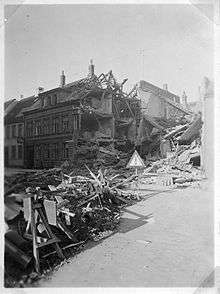
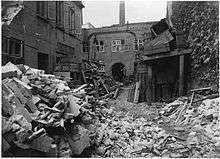
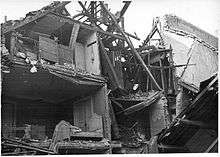

1944
The group performed about 100 acts of sabotage between September 1944 and May 1945. The harbor groups sank or destroyed three ships and damaged or destroyed some 50 factories or businesses. 3 members of the group died during different operations and memorial stone has been erected in Tranbjerg for two of them.[10][11]
| 11 September | Offices of Universalfabrikkerne on Park Allé torched. |
| 13 September | Factory building in Fredensgade bombed. |
| 15 September | Electrical substation in Derbys harbor destroyed. |
| 17 September | Factory in Fredensgade bombed again and destroyed. |
| 26 September | Bike storage on Tordenskjoldsgade 16 bombed. |
| 27 September | Explosion in German marine depot in the harbor. |
| 2 October | 4 German locomotives at Frichs destroyed. |
| 8 October | Mechanics shop on Nordrevej in Åbyhøj torched. |
| 9 October | Offices of Derby destroyed bombed. |
| 9 October | 2 explosions in workshop in the south harbor. |
| 10 October | Steamer Scharnørn sunk at pier with bombs. |
| 13 October | 3 cars bombed in the harbor. |
| 16 October | Cannon emplacement in Marselisborg Lystbådehavn bombed. |
| 24 October | Bombs on rail line between Aarhus and Hasselager. |
| 25 October | Bombs on rail line between Aarhus and Hasselager. |
| 26 October | Bombs on rail line between Aarhus and Hasselager. |
| 26 October | Hauling winge in south harbor destroyed. |
| 27 October | Mechanics shop in Østergade destroyed. |
| 28 October | Air drying facility in Risskov torched. |
| 1 November | Mechanics shop at Kirkegårdsvej 10 torched. |
| 1 November | Mechanics shop at central bus station torched. |
| 2 November | Mechanics shop in Jægergårdsgade 101 torched. |
| 2 November | Cars in Búlows workshop in Trøjborg destroyed. |
| 3 November | 9 track switches between Østbanegården and Aarhus Central Station destroyed. |
| 5 November | Track on the rail line between Aarhus and Hasselager destroyed. |
| 6 November | Factory in Vejlby destroyed. |
| 7 November | 2 cranes in north harbor destroyed. |
| 8 November | Rail line between Aarhus and Risskov damaged. |
| 9 November | Rail line between Aarhus and Skanderborg damaged. |
| 10 November | German concrete mixer destroyed. |
| 13 November | Slipway in south harbor destroyed. |
| 16 November | Fuel station on Randersvej bombed. |
| 16 November | Workshop in Vigenshus bombed. |
| 18 November | 7 rail cars under Frederiksbroen destroyed. |
| 2 December | German package depot at godsbanegården torched. |
| 15 December | Electrical substation in Langelandsgade destroyed. |
| 18 December | Laundry facility in Mejlgade bombed. |
1945
| 2 January | Camouflage material in Viby destroyed. |
| 9 January | Sabotage against German radio vehicle in the harbor. |
| 12 January | German command central in Handelsbankens hus destroyed. |
| 13 January | 2 rail cars under Frederiksbroen destroyed. |
| 23 January | 2 cars bombed. |
| 23 January | Electrical substation at orthopedic hospital destroyed. |
| 25 January | 3 track switches between Aarhus central station and harbor destroyed. |
| 3 February | Factory in Fredensgade torched. |
| 5 February | Extensive sabotage against rail lines around Aarhus. |
| 7 February | Firefight between resistance fighters and German troops in Brabrand. |
| 8 February | Machines in factory in Vejlby destroyed. |
| 8 February | Factory in Bruunsgade 62 torched. |
| 11 February | Extensive sabotage against rail lines north of Aarhus. |
| 19 February | Bombs against DSB bodywork facility. |
| 20 February | German truck bombed on the corner of Samsøgade and Hjarnøgade. |
| 21 February | 5 rail cars destroyed. |
| 22 February | German locomotive in Viby destroyed. |
| 23 February | Bombs between Bruunsbro and Frederiksbro. Firefight breaks out and 2 resistance fighters wounded and one dies. |
| 24 February | Armed robbery against German steamer and ammunition stolen. |
| 26 February | Cars and trucks in Aarhus Hallen in Jægergårdsgade 162 bombed. |
| March 7 | Building on Kystvejen partially destroyed. |
| March 12 | Bombs in offices in Klostergade. |
| March 12 | DSB command central destroyed. |
| March 12 | Railway tracks between Lystrup and Risskov destroyed. |
| March 13 | Extensive rail sabotage. |
| March 16 | Fire set in German fortifications in Risskov. |
| March 18 | Railway bombings between Aarhus and Mundelstrup and at Risskov. |
| March 21 | Bombs placed at Fortevej to keep workers from working on fortification construction. |
| March 22 | Electrical substation on Marselis Boulevard destroyed. |
| March 23 | Failed attack on German plane results in the death of two resistance fighters. |
| March 24 | DSB locomotive between Aarhus and Mundelstrup destroyed. |
| March 25 | Military train derailed between Aarhus and Brabrand. |
| March 27 | Bombs against DSB central repair facility and train depot. |
| March 28 | Workshop in Åbyhøj torched. |
| April 2 | German ship Gotfred Hansen sunken. |
| April 4 | German locomotive in Viby destroyed. |
| April 5 | Phone masts between Langelandsgade Kaserne and Vorrevangen destroyed. Firefight between resistance fighters and German troops. |
| April 5 | Several bombs under cargo train in Brabrand. |
| April 6 | 10 German vehicles destroyed in Spanien. |
| April 6 | Several track switches destroyed. |
| April 8 | Cables for Wehrmacht emergency central destroyed. |
| April 9 | Warning bombs against worker barracks in Tøndergade. |
| April 11 | Rail line to Brabrand damaged. |
| April 11 | Several German cars destroyed. |
| April 12 | Rail line to Brabrand damaged. |
| April 12 | German barracks at the central train station blown up. |
| April 14 | Car bomb against truck company on Nordre Strandvej. |
| April 14 | 20 explosions in railyard. |
| April 15 | Locomotive derailed at Brabrand. |
| April 16 | German ship engine in factory destroyed. |
| April 16 | 2 German express boats destroyed. |
| April 16 | Teargas bombs against guardhouse in Nygade. |
| April 17 | 8 bombs against cannon emplacements at Riisvangen. |
| April 19 | German steamer Anni on slipway in harbor destroyed. |
| April 20 | 3 trucks destroyed. |
| April 20 | Rail line between Aarhus and Brabrand bombed. |
| April 21 | Workshop in Åbyhøj torched. |
| April 23 | Several trucks destroyed. |
| April 24 | Rail sabotage at Brabrand. |
| April 26 | Hipo cars destroyed. |
| April 26 | Workshop in Brabrand torched. |
| April 27 | Villa in Risskov bombed. |
| May 1 | Bombs in cargo railyard. |
| May 3 | Extensive rail sabotage. |
| May 4 | Extensive rail sabotage. |
References
- ↑ "Modstandsfolk i den gamle by" (in Danish). The Old Town Museum. Retrieved 16 September 2015.
- ↑ Hauerbach 1945, p. 13.
- ↑ Hauerbach 1945, p. 14.
- ↑ "Silkeborgkontorets sidste dage" (in Danish). Tidsskrift. Archived from the original on 2016-06-10. Retrieved 16 September 2015.
- ↑ "I dette øjeblik meddeles det" (in Danish). Århus Stiftstidende. Archived from the original on 2016-06-10. Retrieved 9 June 2016.
- ↑ Fode 2005, p. 46.
- 1 2 Hauerbach 1945, p. 15.
- 1 2 3 Hauerbach 1945, p. 16.
- ↑ Hauerbach 1945, p. 1.
- ↑ Hauerbach 1945, p. 25.
- ↑ "Mindestenen på Ellemosevej" (PDF) (in Danish). Tranbjerg lokalhistorisk forening. Retrieved 16 September 2015.
- Publications
- Sven, Hauerbach (1945). 5. Kolonne; Aarhus-sabotørernes modige indsats. Published by 5 Kolonne. Archived from the original on 2016-04-15. Retrieved 2015-09-18.
- Fode, Henrik (2005). Århus besat. Århus Byhistoriske Fond. ISBN 879-1-324-114.
